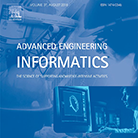In Germany, bridges have an average age of 40 years. A bridge consumes between 0.4% and 2% of its construction cost per year over its entire life cycle. This means that up to 80% of the construction cost are additionally needed for operation, inspection, maintenance, and destruction. Current practices rely either on paper-based inspections or on abstract specialist software. Every application in the inspection and maintenance sector uses its own data model for structures, inspections, defects, and maintenance. Due to this, data and properties have to be transferred manually, otherwise a converter is necessary for every data exchange between two applications. To overcome this issue, an adequate model standard for inspections, damage, and maintenance is necessary. Modern 3D models may serve as a single source of truth, which has been suggested in the Building Information Modeling (BIM) concept. Further, these models offer a clear visualization of the built infrastructure, and improve not only the planning and construction phases, but also the operation phase of construction projects. BIM is established mostly in the Architecture, Engineering, and Construction (AEC) sector to plan and construct new buildings. Currently, BIM does not cover the whole life cycle of a building, especially not inspection and maintenance. Creating damage models needs the building model first, because a defect is dependent on the building component, its properties and material. Hence, a building information model is necessary to obtain meaningful conclusions from damage information. This paper analyzes the requirements, which arise from practice, and the research that has been done in modeling damage and related information for bridges. With a look at damage categories and use cases related to inspection and maintenance, scientific literature is discussed and synthesized. Finally, research gaps and needs are identified and discussed.
More information can be found here.









